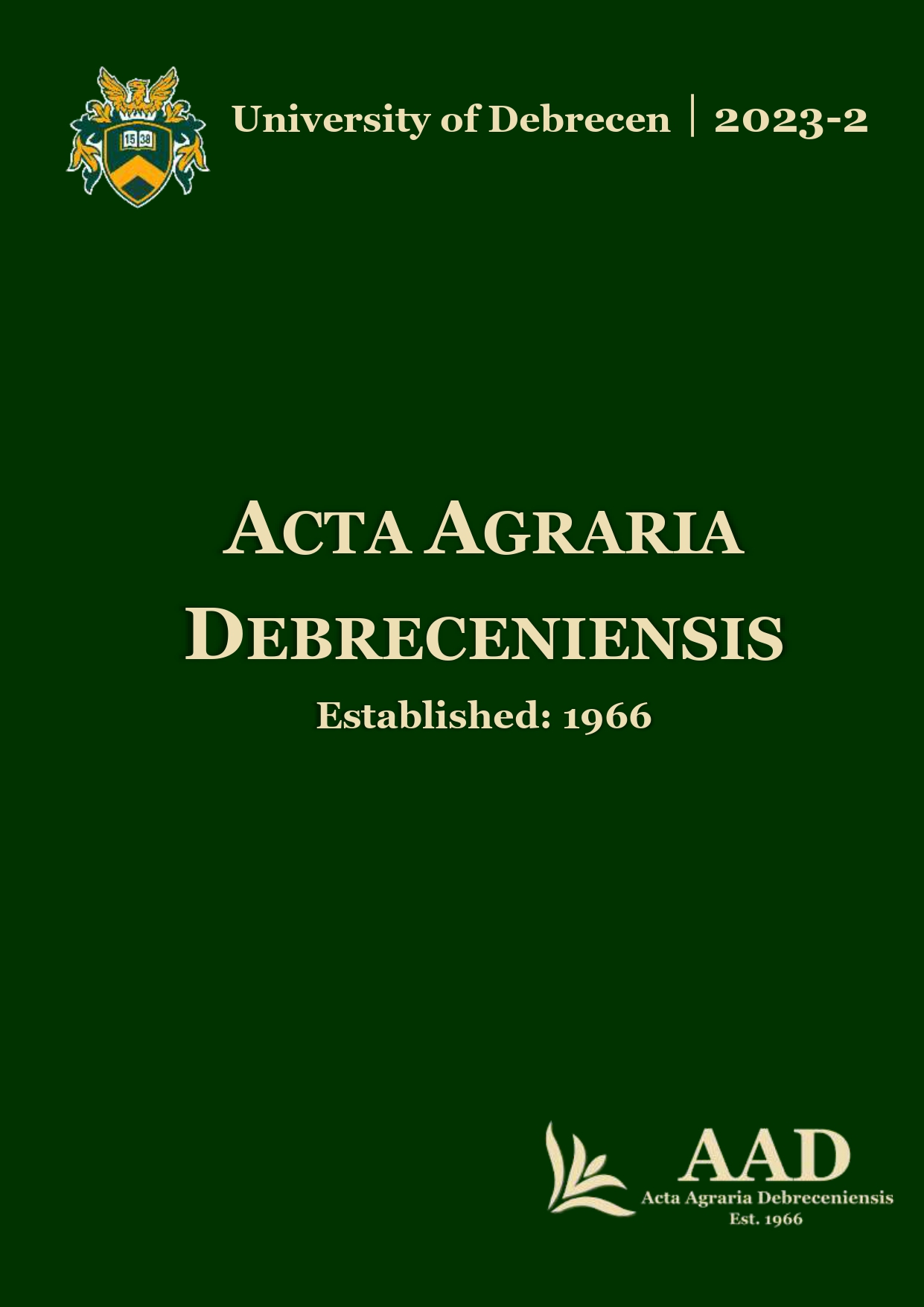Investigation of the effect of allithiamine-enriched feed on the poultry gut microbiome composition and resistome
Authors
View
Keywords
License
Copyright (c) 2023 by the Author(s)

This work is licensed under a Creative Commons Attribution 4.0 International License.
How To Cite
Accepted 2023-09-28
Published 2023-12-01
Abstract
Over the past 20–25 years, the poultry industry has evolved into a specific protein production system. However, the stress resulting from intensive rearing practices has led to numerous negative consequences, making the optimisation of livestock gut microbiome composition crucial for mitigating these effects. Advancements in modern molecular biology methods have brought attention to the impacts of nutrients on gut microbiota. In our study, we extensively investigated the changes induced by feed formulations rich in phytonutrients on the gastrointestinal microbiota of livestock using targeted 16S rRNA amplicon sequencing. Our objective is to examine how the developed feed prototype affects the composition of core microbiomes in raised poultry, community diversity, and the resilience of complex microbial networks. We seek correlations between biological livestock and environmental samples to identify which community constituents, in what proportions and occurrences, may play a role in the development of specific diseases. Based on our measurement results, it can be asserted that allithiamine positively modulated "beneficial" community constituents. Beyond the impact of allithiamine-enriched feed rich in phytonutrients, the composition of the microbial community in the poultry gastrointestinal tract is significantly influenced by the age of the birds. Furthermore, due to the presence of multi-drug-resistant pathogens in environmental samples from livestock facilities, appropriate transmission risk management measures are of paramount importance.
References
- Cheng, D.–Feng, Y.–Liu, Y.–Xue, J.–LI, Z. (2019): Dynamics of oxytetracycline, sulfamerazine, and ciprofloxacin and related antibioticresistance genes during swine manure composting. J. Environ. Manag. 230, 102–109. https://doi.org/10.1016/j.jenvman.2018.09.074
- Clavijo, V.–Flórez, M.J.V. (2018): The gastrointestinal microbiome and its association with the control of pathogens in broiler chicken production: a review. Poult Sci 97:1006–1021. https://doi.org/10.3382/ps/pex359.
- Crhanova, M.–Hradecka, H.–Faldynova, M.–Matulova, M.–Havlickova, H.–Sisak, F. (2011): Immune response of chicken gut to natural colonization by gut microflora and to Salmonella enterica serovar enteritidis infection. Infect Immun. 79:2755–63. doi: 10.1128/IAI.01375-10
- Dibner, J.J.–Richards, J.D. (2005): Antibiotic growth promoters in agriculture history and mode of action. Poult Sci. 84:634–43.
- Fidler, G.–Tolnai, E.–Stagel, A. (2020): Tendentious effects of automated and manual metagenomic DNA purification protocols on broiler gut microbiome taxonomic profiling. Sci Rep 10, 3419 2020. https://doi.org/10.1038/s41598-020-60304-y
- Kau, A.L.–Ahern, P.P.–Griffin, N.W.–Goodman, A.L.–Gordon, J.I. (2011): Human nutrition, the gut microbiome and the immune system. Nature. 474:327–36.
- Kers, J.G.–Velkers, F.C.–Fischer, E.A.J.–Hermes, G.D.A.–Stegeman, J.A.–Smidt, H. (2018): Host and environmental factors affecting the intestinalmicrobiota in chickens. FrontMicrobiol 9:235. https://doi.org/10.3389/fmicb.2018.00235.
- Lan, Y.–Verstegen, M.W.A.–Tamminga, S.–Williams, B.A. (2005): The role of the commensal gut microbial community in broiler chickens. Worlds Poult Sci J 61:95–104. https://doi.org/10.1079/WPS200445.
- Li, X.–Cao, Z.–Yang, Y.–Chen, L.–Liu, J.–Lin, Q.–Qiao, Y.–Zhao, Z.–An, Q.–Zhang, C.–Li, Q.–Ji, Q.–Zhang, H.–Pan, H. (2019): Correlation between jejunal microbial diversity and muscle fatty acids deposition in broilers reared at different ambient temperatures. Sci Rep 9:11022. https://doi.org/10.1038/s41598 -019-47323-0
- Mcallister, T.A.–Wang, Y.–Diarra, M.S.–Alexander, T.–Stanford, K. (2018): Challenges of a one-health approach to the development of alternatives to antibiotics. Anim. Front. 8, 10–20. https://doi.org/10.1093/af/vfy002
- Pandey, K.R.–Naik S.R.–Vakil, B.V. (2015): Probiotics, prebiotics and synbiotics —a review. J Food Sci Technol. 52:7577–7587. https://doi.org/10.1007/s13197-015-1921-1.
- Sarangi, N.R.–Babu, L.K.–Kumar, A.–Pradhan, C.R.–Pati, P.K.–Mishra, J.P. (2016): Effect of dietary supplementation of prebiotic, probiotic, and synbiotic on growth performance and carcass characteristics of broiler chickens. Vet World 9:313–319. https://doi.org/10.14202/vetworld.2016.313-319
- Segata, N.–Izard, J.–Waldron, L.–Gevers, D.–Miropolsky, L.–Garrett, W.S.–Huttenhower, C. (2011): Metagenomic biomarker discovery and explanation. Genome Biol 12:R60. https://doi.org/10.1186/gb-2011-12-6-r60.
- Siddiqui, R.A.–Moghadasian, M.H. (2020): Nutraceuticals and nutrition supplements: challenges and opportunities. Nutrients 12:1593. https://doi .org/10.3390/nu12061593.
- Singer, R.S.–Finch, R.–Wegener, H.C.–Bywater, R.–Walters, J.–Lipsitch, M. (2003): Antibiotic resistance—The interplay between antibiotic use in animals and human beings. Lancet Infect. Dis. 3, 47–51. https://doi.org/10.1016/S1473-3099(03)00490-0
- Sommer, F.–Bäckhed, F. (2013): The gut microbiota—masters of host development and physiology. Nat Rev Microbiol 11:227–238. https://doi.org/ 10.1038/nrmicro2974.
- Stanley, D.–Denman, S.E.–Hughes, R.J.–Geier, M.S.–Crowley, T.M.–Chen, H.–Haring, V.R.–Moore, R.J. (2012): Intestinal microbiota associated with differential feed conversion efficiency in chickens. Appl Microbiol Biotechnol 96:1361–1369. https://doi.org/10.1007/s00253-011-3847-5.
- Stanley, D.–Hughes, R.J.–Moore, R.J. (2014): Microbiota of the chicken gastrointestinal tract: influence on health, productivity and disease. Appl Microbiol Biotechnol 98:4301–4310. https://doi.org/10.1007/s00253-014-5646-2.
- Wideman, R.F.–Chapman, M.E.–Hamal, K.R.–Bowen, O.T.–Lorenzoni, A.G.–Erf, G.F.–Anthony, N.B. (2007): An inadequate pulmonary vascular capacity and susceptibility to pulmonary arterial hypertension in broilers. Poult Sci 86:984–998. https://doi.org/10.1093/ps/86.5.984.
- Yegani, M.–Korver, D.R. (2008): Factors affecting intestinal health in poultry. Poult Sci. 87:2052–63. doi: 10.3382/ps.2008-00091

 https://doi.org/10.34101/actaagrar/2/13257
https://doi.org/10.34101/actaagrar/2/13257